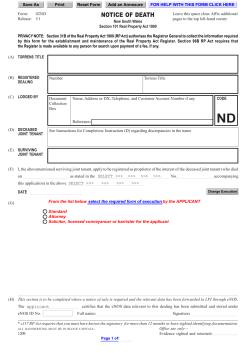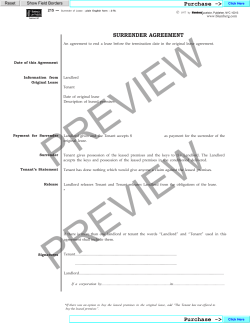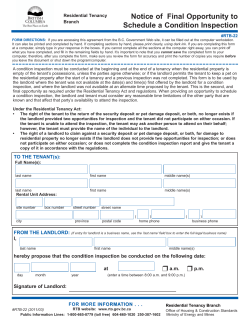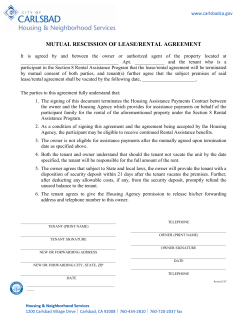
L La an nd
DO FRE E W of NLO ch samp AD a pte le rs! Landlord & Tenant Act 1954 Contents This is a sample of the Landlord & Tenant Act 1954 Law Guide. To access a full version, featuring all the chapters listed below, please subscribe here Please click on any heading in black to go straight to that page Landlord & Tenant Act Law G u i d e Sample Jacqui Joyce Index and Author Biography 03 Introduction 04 Contracting out of security of tenure 08 Surrenders 33 To whom does the Act apply? 40 Information gathering – section 40 notices 45 The renewal process – notices and counternotices 55 The renewal process – applications to the court for a new tenancy 63 Termination proceedings by a landlord 71 Changes to the Civil Procedure Rules 78 Termination of fixed-term tenancies by a tenant– section 27 100 Interim rent 102 Terms of a new tenancy ordered by the court 118 Compensation 120 To access the full version subscribe here now! KEY Links to Practical Conveyancing.co.uk pages and other pages within this document Links to external websites Practice Points occur throughout the text and are displayed in separate boxes. Their position in the text may be indicated where necessary by numbering (eg 1, 2, 3). Practical Conveyancing.co.uk © Practical Conveyancing.co.uk 2 LTA LANDLORD & TENANT ACT Index Introduction 04 Contracting out of security of tenure 08 Surrenders 33 Jacqui Joyce To whom does the Act apply? 40 Information gathering – section 40 notices of Lovells 45 The renewal process – notices and counternotices 55 The renewal process – applications to the court for a new tenancy 63 Termination proceedings by a landlord 71 Changes to the Civil Procedure Rules 78 Termination of fixed-term tenancies by a tenant– section 27 100 Interim rent 102 Terms of a new tenancy ordered by the court 118 Compensation 120 Jacqui Joyce qualified as a solicitor in 1991 and since then has been an assistant in Lovells’ property litigation department. She has extensive experience of all types of property disputes, including acting on several reported cases. Jacqui provides specialist advice to clients in relation to legislative developments and procedural reforms in the commercial property sector. Jacqui is a member of the London Property Support Lawyers Group and a member of the Property Litigation Association’s Law Reform Committee. She is also an accredited mediator with the ADR Group and regularly contributes to property journals. Main Index 02 Law G u i d e Sample To access the full version subscribe here now! Practical Conveyancing.co.uk 3 LTA Surrenders Actual surrenders 33 Agreements to surrender 33 The health warning notice 33 The first requirement of Schedule 4 to the Order – the declarations 35 The second requirement of Schedule 4 to the Order 37 Practical issues 38 It is important to remember when looking at surrenders that there is a distinction between an actual surrender of a lease and an agreement to surrender a lease at some point in the future. New procedures have been introduced for authorising agreements to surrender. Actual surrenders All actual surrenders (ie immediate surrenders without any prior agreement) are now valid. There is no longer any prohibition against surrenders during the first month of the tenancy. Agreements to surrender The provisions which deal with agreements to surrender are in the new s38A of the Act and Schedules 3 and 4 to the Order. Section 38A(2) provides that the parties may agree that the tenancy shall be surrendered ‘on such date or in such circumstances as may be specified in the agreement and on such terms (if any) as may be so specified’. Section 38A(4) provides that such an agreement will be void unless: Law G u i d e Sample • the landlord has served on the tenant a notice in the form, or substantially in the form, set out in Schedule 3 to the Order (the ‘health warning notice’); and • the requirements of Schedule 4 to the Order are met. The health warning notice To access the full version subscribe here now! Practical Conveyancing.co.uk As mentioned above, the form of the health warning notice is set out in Schedule 3 to the Order. A copy of the form of notice is at [insert link]. Contents of the health warning notice The health warning notice specifically informs the tenant that it is giving up legal rights, in particular it states: • the tenant would normally have a right to renew its lease when 33 LTA Surrenders it expires, but by agreeing to surrender it will give up this statutory right; • the tenant will not be able to continue to occupy the premises beyond the date provided for under the agreement for surrender, unless the landlord chooses to offer a further term (in which case the tenant would lose the right to ask the court to determine the new rent); • the tenant will need to leave the premises; and • the tenant will be unable to claim compensation for the loss of the premises, unless the lease or agreement for surrender gives it this right. The notice informs the tenant it is important to get professional advice before committing itself to the agreement to surrender. It also explains the simple declaration and statutory declaration procedures. Completing the health warning notice The landlord is required to fill in to complete the health warning notice only the following: • the name and address of the tenant to which the notice is being sent; and Law G u i d e Sample To access the • the name and address of the landlord from whom the notice is sent. There is no requirement to fill in the details of the property, or the lease, or the agreement to surrender to which the notice relates. There is also no requirement to sign or date the notice. PRACTICE POINT full version subscribe here now! Practical Conveyancing.co.uk Whilst there is no requirement to refer to the premises, a landlord may wish to put details of the premises on the notice, and the date it was sent, to avoid confusion later. If the landlord is being very cautious he may wish to attach a copy of the agreement to surrender although this is not required. 34 LTA Surrenders The first requirement of Schedule 4 to the Order – the declarations Section 38A(4)(b) provides that an agreement to surrender will be void unless the requirements in Schedule 4 to the Order are met. The requirements vary slightly depending on when the health warning notice is served. It depends whether or not the notice is served ‘not less than 14 days before the tenant enters into the agreement under s38A(2)… [ie the agreement to surrender] or (if earlier) becomes contractually bound to do so’. The simple declaration – where the health warning notice is served not less than 14 days before the tenant enters into the agreement to surrender or becomes contractually bound to do so If not less than 14 days’ notice is given to the tenant paragraph 3 of Schedule 4 to the Order provides that: The tenant or a person duly authorised by him to do so, must, before the tenant enters into the agreement under s38A(2) of the Act , or (if earlier) becomes contractually bound to do so, make a declaration in the form, or substantially in the form, set out in paragraph 6. Law G u i d e Sample To access the The form of this simple declaration is at [link]. Contents of the simple declaration The simple declaration by the tenant needs to have the following completed: • the name and address of the person making the declaration; full version • the name of the tenant; subscribe here now! • the term commencement date of the tenancy; and Practical Conveyancing.co.uk • the premises in the tenancy; • the name of the landlord. 35 LTA Surrenders The declaration records: • that the tenant has a tenancy of the premises and the date the term commenced; • that the tenant proposes to enter into an agreement with the landlord to surrender the tenancy on a date or in circumstances specified in the agreement; • that the landlord has, not less than 14 days before the tenant enters into the agreement or (if earlier) becomes contractually bound to do so, served the health warning notice; • that the form of the health warning notice is set out in the declaration; • that the tenant has read the notice and accepts the consequences of entering into the agreement to surrender; and • if appropriate, confirms that the declarant is duly authorised by the tenant to make the declaration. The statutory declaration – where the health warning notice is served less than 14 days before the tenant enters into the agreement to surrender or (if earlier) becomes contractually bound to do so Law G u i d e Sample To access the If less than 14 days’ notice is given to the tenant paragraph 4 of Schedule 4 to the Order provides that: … the notice… must be served on the tenant before the tenant enters into the agreement [to surrender], or (if earlier) becomes contractually bound to do so, and the tenant, or a person duly authorised by him to do so, must before that time make a statutory declaration in the form, or substantially the form, set out in paragraph 7. full version The form of statutory declaration is at [link]. subscribe here now! Contents of the statutory declaration The contents of the statutory declaration, and the information which needs to be completed, are almost exactly the same as the simple declaration (see [link?] above). Practical Conveyancing.co.uk 36 LTA Surrenders The differences are: • The declaration records that the health warning notice was served, but does not say when, ie it does not state less than 14 days’ notice was given. • The deponent has to ‘solemnly and sincerely declare’ rather than just ‘declare’. The deponent must make the statutory declaration within the meaning of the Statutory Declaration Act 1835. They must make the declaration before an independent solicitor (or other person qualified to administer oaths) and pay the prescribed fee which is currently £5. For the practical aspects of making the statutory declaration, see Contracting out of security of tenure above. The second requirement of Schedule 4 to the Order Paragraph 5 of Schedule 4 to the Order provides that the ‘instrument creating the agreement to surrender’ (ie the agreement to surrender) must contain or have endorsed on it: • a reference to the health warning notice; and Law G u i d e • a reference to the simple declaration or statutory declaration as appropriate. Sample Suggested wording for this endorsement is as follows, (obviously this may need to be varied depending on the individual circumstances of the case): To access the 1. This agreement to surrender has been authorised in accordance with the provisions of s38A(4) of the Landlord and Tenant Act 1954. In accordance with those provisions: full version subscribe here now! Practical Conveyancing.co.uk (a) the landlord has served on the tenant a notice in the form, or substantially in the form, set out in Schedule 3 to the Regulatory Reform (Business Tenancies) (England and Wales) Order 2003 (the ‘Order’); and (b) the requirements specified in Schedule 4 to the Order have been met in that the tenant has made a [statutory*] declaration 37 LTA Surrenders in the form, or substantially in the form, set out in paragraph [6*] [7*] of Schedule 4 to the Order. *delete as appropriate. • Paragraph 6 is referred to where the tenant has made a simple declaration, ie where the health warning notice was served not less than 14 days before the tenant entered into the agreement to surrender or became contractually bound to do so. The words ‘statutory’ and ‘paragraph 7’ should be deleted. • Paragraph 7 is referred to where the tenant has made a statutory declaration, ie where the health warning notice was served less than 14 days before the tenant entered into the agreement to surrender or became contractually bound to do so. References to ‘paragraph 6’ should be deleted. PRACTICE POINT Where the parties do not know at the time of engrossing the agreement to surrender whether more or less than 14 days’ notice will be given it is suggested they could use the following alternative wording for paragraph (b) above: Law G u i d e Sample (b) The requirements specified in Schedule 4 to the Order have been met in that the tenant has made the appropriate declaration in the form, or substantially in the form, set out in Schedule 4 to the Order. To access the Note: These provisions only apply to agreements to surrender, they do not need to be complied with where the tenancy is just surrendered without a prior agreement. full version Practical issues subscribe here now! Practical Conveyancing.co.uk The practical issues which arise in relation to agreements to surrender are more or less the same as those that arise in relation to contracting out of the security of tenure provisions – eg how to serve the notice, evidence of service, who should it be served on, who 38 LTA Surrenders should make the declaration etc. For a detailed analysis of these issues, see Contracting out of security of tenure. What if the tenancy is contracted out of the Act The new provisions do not change the law on this point. Section 38A(2) of the Act (as did s38(4) before it) applies only to tenancies ‘to which this part of this Act (ie Part II) applies’. Therefore, if the tenancy is not one to which Part II of the Act applies (eg because it has been contracted out), the provisions relating to agreements for surrender are of no effect, ie the parties may enter into a valid and binding agreement to surrender the tenancy without serving health warning notices, etc. Transitional provisions Article 29 of the Order sets out the transitional provisions. It specifically provides that nothing in the Order shall have effect in relation to an agreement for the surrender of a tenancy: • which was made before 1 June 2004 fell within s24(2)(b) of the Act, ie was made before the tenant had been in occupation for one month (therefore, such agreements made before 1 June 2004 will still be invalid); and Law G u i d e • which was authorised by the court under s38(4) of the Act before 1 June 2004. Such an agreement to surrender will still be valid. Sample To access the full version subscribe here now! Practical Conveyancing.co.uk 39 LTA Termination of fixed-term tenancies by a tenant– section 27 Termination by the tenant before end of the fixed term – section 27(1) 100 Termination by tenant after the end of the fixed term – section 27(2) 100 Transitional provisions 101 Termination by the tenant before end of the fixed term – section 27(1) Section 27(1) of the Act has been amended to make it clear that a tenant wishing to end the tenancy at the end of the contractual term can do so by: 1. serving at least three months’ notice before the end of the contractual term; or 2. not being in occupation of the premises by the end of the contractual term. The result in 1 above has been achieved by the insertion of a new s27(1A) which provides that s24 of the Act (continuing the tenancy after the end of the contractual term unless terminated in accordance with the Act) shall not have effect where the tenant is not in occupation of the property at the end of the contractual term. Law G u i d e Where the tenant has moved out the tenancy will, therefore, end on the expiry of the contractual fixed term without the need for either party to serve any notices. This creates uncertainty for a landlord up to the end of the fixed term. It would be possible for a tenant who has vacated (without serving a section 27 notice) to move back in to the premises in the last few days of the term and thereby reactivate its protection under the Act. Sample Termination by tenant after the end of the fixed term – section 27(2) To access the There have been three amendments to s27(2) of the Act. A tenant wishing to quit, where the tenancy has continued beyond the end of the contractual fixed term has to give the landlord three months’ prior written notice. full version subscribe here now! Practical Conveyancing.co.uk When is the notice to end? Section 27(2) has been amended to remove the requirement that the three months’ notice must end on a quarter day. It may end now on any day. 100 LTA Termination of fixed-term tenancies by a tenant– section 27 What happens if the tenant moves out without serving a notice? Section 27(2) has been amended to make it clear that a tenancy continuing after the end of the contractual expiry date ‘shall not come to an end by reason only of the tenant ceasing to occupy the property comprised in the tenancy’. This is in contrast to the position before the end of the contractual fixed term (see above). To bring its tenancy to an end after the expiry of the contractual fixed term the tenant will have to serve a section 27(2) notice, ie it cannot just move out. Apportionment of rent Normally where a tenancy comes to an end midway through a rental period, rent (if payable in advance) will not be apportioned. So if a tenancy (where rent is payable quarterly) is brought to an end on 28 June, the tenant will still be obliged to pay the full amount for the June quarter, even though he is only occupying for four days of that quarter. A new s27(3) of the Act provides for the apportionment of rent after a section 27(2) notice has been served. The tenant will pay rent up to the actual date for the ending of the tenancy, where the end of the notice period is not the same as the end of the rental period. Any excess rent already paid by the tenant in advance to the landlord will be recoverable by the tenant. Law G u i d e Sample To access the full version subscribe here now! Practical Conveyancing.co.uk Example: There is a five-year lease expiring on 25 December 2004. The tenant remains in occupation after the end of the fixed term. In April 2005 the tenant serves at least three months’ notice under s27(2) of the Act ending on 25 July 2005. The tenancy will end on 25 July 2005 (and not the end of the quarter – 28 September 2005). Rent will only be payable until 25 July 2005. If the quarter’s rent due on 24 June 2005 has already been paid then the tenant will be entitled to a refund for the apportioned amount for the period from 26 July 2005 to 28 September 2005. Transitional provisions The transitional provisions in Art 29(2)(b) of the Order provide that nothing in the Order has effect in relation to a notice under s27(2) of the Act (notice by tenant to terminate tenancy after the end of the fixed term) which was given by the tenant to the immediate landlord before the Order came into force, ie before 1 June 2004. 101 LTA Law G u i d e Sample To access the full version subscribe here now! Practical Conveyancing.co.uk LTA
© Copyright 2025









